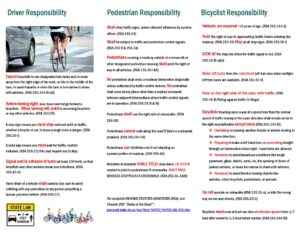Pedestrian & Bicycle Safety
NH Office of Highway Safety
This user-friendly pamphlet summarizes New Hampshire’s laws regarding bicyclists and motorists sharing the road. Click HERE to view or download this two-page pamphlet.
Driver Responsibility
Expect bicyclists to use designated turn lanes and to move away from the right edge of the road, or ride in the middle of the lane, to avoid hazards or when the lane is too narrow to share with vehicles. (RSA 265:144-XI-(d))
Before turning right, slow down and merge behind a bicyclists. When turning left, yield to oncoming bicyclists or any other vehicles. (RSA 265:29)
A stop sign means you must stop and wait until no traffic, whether a bicycle or car, is close enough to be a danger. (RSA 265:30-I)
A yield sign means you must wait for traffic, cyclists included. (RSA 265:31) This may require you to stop.
Signal well in advance of turns (at least 100 feet), so that bicyclists and other vehicles know your intentions. (RSA 265:45-II)
Every driver of a vehicle shall exercise due care to avoid colliding with any pedestrian or any person propelling a human-powered vehicle. (RSA 265:37)
Pedestrian Responsibility
Shall obey traffic signs, unless directed otherwise by a police officer. (RSA 265:34)
Shall be subject to traffic and pedestrian control signals. (RSA 265.9 & 265.34)
Pedestrians crossing a roadway outside of a crosswalk or other designated pedestrian crossing shall yield the right of way to all vehicles. (RSA 256.36 I &II)
No pedestrian shall cross a roadway intersection diagonally unless authorized by traffic control devices; No pedestrian shall cross at any place other than a marked crosswalk between adjacent intersections where traffic control signals are in operation. (RSA 265;36 III & IV)
Pedestrians shall use the right side of crosswalks. (RSA 265:38)
Pedestrians cannot walk along the road if there is a sidewalk provided. (RSA 265:39-I-III)
Pedestrians can hitchhike only if not standing on a paved portion of roadway. (RSA 265:40) Motorists & bicyclists SHALL YIELD, slow down, OR STOP if needed to yield to pedestrians IN crosswalks. DON’T PASS VEHICLES STOPPED AT A CROSSWALK. (RSA 265:35-1&IV)
Bicyclist Responsibility
Helmets are required <16 years of age. (RSA 265:144-X)
Yield the right of way to approaching traffic before entering the roadway. (RSA 265:32) Stop at all stop signs. (RSA 265:30-I)
STOP AT the stop line when the traffic signal is red. (RSA 265:10-III a&d)
Make left turns from the outermost left turn lane when multiple left turn lanes are available. (RSA 265:42-II)
Ride on the right side of the road, with traffic. (RSA 265:16-II) Riding against traffic is illegal.
Bicyclists traveling upon a way at a speed less than the normal speed of traffic moving in the same direction shall remain as far to the right as practicable except when (RSA 265:144-XI):
- Overtaking or passing another bicycle or vehicle moving in the same direction;
- Preparing to make a left-hand turn, or proceeding straight through an intersection where right – hand turns are allowed;
- Necessary to avoid hazardous conditions like rough pavement, glass, debris, sand, ice, the opening of doors of parked vehicles, or lanes too narrow to share with vehicles;
- Necessary to avoid fixed or moving objects like vehicles, other bicyclists, pedestrians, or animals.
Do not operate on sidewalks (RSA 265:26-a), or ride the wrong way on one-way streets. (RSA 265:23-II)
Bicyclists must wear at least one item of reflective apparel from 1/2 hour after sunset to 1/2 hour before sunrise. (RSA 265:144-XII)
DID YOU KNOW?
There are many benefits to walking and bicycling, including health, environment and economics.
In NH, bicyclists have the same rights and duties as drivers of motor vehicles. (RSA 265:143)
It is illegal for motor vehicle drivers to open a vehicle door on the side available to moving bicyclists unless reasonably safe to do so. (RSA 265:96)
Using devices such as cell phones, headphones or earbuds when walking or biking can distract you. Always pay attention to your surroundings.
Every driver of a vehicle, when approaching a bicyclist, is required to ensure the safety and protection of the bicyclist and exercise due care by leaving a reasonable and prudent distance between the vehicle and the bicycle. The distance shall be presumed to be reasonable and prudent if it is at least 3 feet when the vehicle is traveling at 30 mph or less, with one additional foot of clearance required for every 10 mph over 30 mph. (RSA 265:143-a)
When biking during darkness, using a white front headlight and a red rear light or rear reflector that is visible from 300 feet significantly increases visibility to other road users.
A sidewalk is the safest location for pedestrians to walk. If there is no sidewalk, it is safest to walk facing traffic instead of in the same direction as traffic.
Pedestrians and bicyclists wearing fluorescent colors during daytime and reflective items during darkness significantly increase visibility to other road users.




